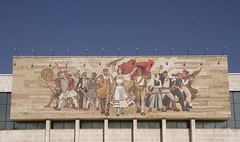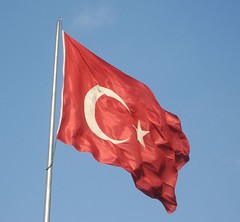As we shivered away at Lake Ohrid in Macedonia, Albania felt like a rather looming presence on the other side of the lake. We weren’t entirely convinced that visiting was such a good idea, primarily due to the scaremongering in our guidebook and on the Foreign Office website, which both suggest a backward country with poor roads, poor manners and lots of guns. In the end we took a deep breath, ignored the fact that we’d be uninsured and un-rescuable, and headed off into Albo-land.
As seems to be the case in almost all of these situations, reality is somewhat different from what we had read. The Albanian side of the lake immediately felt different, but not necessarily in a bad way. Admittedly we did have to divert off-road through a nearby field within the first 5km; the towns were more run down; and the pretty Macedonian buildings had been replaced with concrete blocks. But it didn’t feel at all threatening. In fact, as we wound our way around the coast, pedestrians smiled and waved at us more than they have anywhere since Pakistan. It also quickly became clear that Albania has some awesome scenery, lovely scrubby mountains with sweeping roads which provide excellent views in all directions.
The country seems to have a huge number of men of all ages just hanging around with nothing much to do: grey coats, black jumpers, flat caps and endless cigarettes seems to be the uniform of choice. Albania is also overrun with very old Mercedes Benz cars, which seemed to make up about 80% of the vehicles on the road. According to the mine of information that is Mr Richard Stuart Taylor, they were the only cars that could be brought in during the years in which Albania was a closed country – something to do with the local mafia, apparently. In any event, it appears to be compulsory for all old Mercedes to be in one of a palette of dreadful colours: snotty green, deep maroon, mud brown, mustard yellow… you get the picture. There is absolutely no problem getting your Merc washed, though. Never have we seen a country with so many hand car washes, all vying for your attention by spraying jets of water high in the air or leaving their hosepipes on during the winter to create big icicle displays.
Albania was run by an extreme communist dictator until 1985; was totally closed to the outside world for quite some time; and had, officially, no friends (having fallen out with each of its big three allies - Yugoslavia, the USSR and China – in turn). As we wound our way through the countryside to Tirana, we started to see one of the legacies of the country’s isolation. In his quest to protect the country from the rest of the world, the aforementioned communist dictator (one Enver Hoxha) spent 35 years having 700,000 concrete gun bunkers built. They were so well protected against invaders that the Albanians now can’t get rid of them. So they still dot the landscape like a series of bizarre concrete mushrooms set into the earth: by the side of roads, in the middle of fields, on beaches; in fact pretty much everywhere. Very odd.
Tirana, the capital, is a bustling place where we had been warned that we’d need to find secure parking due to high levels of vehicle theft. We somewhat reluctantly, checked into the central ‘Hotel California’ to get ourselves both secure parking and registration with the authorities. Upon embarking on a tour of the city, it became clear that to enjoy Tirana, one needs to be a fan of rather less conventional sights. There is an impressive tiled mural dominating the main square which modestly shows Albanians winning many wars over the years, from the 1800s right up until World War II (which I hadn’t realised that they’d won – but then what do I know). Alongside the main boulevard are some quite attractive yellow buildings (built by the Italians as a present); lots and lots and lots of concrete; an open sewer standing in as a central river; and a large concrete pyramid labelled ‘Kosovo’. The other ‘highlight’ was a peek at the house where Dictator Hoxha, used to live – it has now been turned into a Foreign Language school but still has shady looking military types wandering around the garden with suitably scary guns. Luckily for us we were able to find a very nice French Patisserie nearby which held our attention for a little longer than the concrete tower blocks.
After a brief excursion to the Albania coastal resort of Durres (which is another adventure in concrete), we spent our final night in the country at the beautifully located hill town of Kruje. The town features yet another castle (I swear that I will have looked well over 100 castles by the time I get home), this time featuring a rather incongruously modern ‘Albanian War Museum’ built on top of it by no less than Mr. Hoxha’s own daughter. We rejected this for a visit to the ‘Ethnographical Museum’ where an endearing old chap enthusiastically showed us how the local gentry used to live. Once we’d seen him simulating the crushing of olives, making pottery, serving meals and baking bread, it was a case of hurrying back to the shady car park nearby to ensure that the child with whom we’d left $2 to look after the van hadn’t instead flogged it.
From Albania, the coast road travels north and re-enters the old Yugoslavia, now called Crna Gora locally (Montenegro to us). This is, at least until the Kosovo situation is slightly more sorted out, the world’s newest country, though any new-found patriotism doesn’t seem to stop it from having the world’s grumpiest border guards. We arrived in the rain at the coastal ‘resort’ of Ulcinj, where Helen spent the afternoon snoozing on the seafront, watching the waves. I, meanwhile, ran around in the drizzle trying to change our remaining Albanian money and find a suitable policeman with whom to register ourselves. Unfortunately I was having little success on either front. The Montenegrins are about as interested in Albanian Lek as they would be in Monopoly money. Upon arriving at the police station somewhat bedraggled I was laughed at, offered whisky and then sent packing (unregistered) by a burly, rather malodorous officer. Eventually though, a local travel agent both sorted out our registration and rather randomly found an Albanian bus driver who was prepared to only rip us off a bit on the exchange rate.
We slept well on the seafront and then embarked on some beautiful days driving along the picturesque coast. The Adriatic here has some of the finest landscape that we have seen anywhere, with beautiful bays and mountains that sweep down to the clear, blue-green sea below. We had some stunning wild camps high up in the mountains, meaning that we could eat breakfast with gorgeous views. The mountain road over to Kotor, the location of Southern Europe’s deepest fjord, is a really spectacular series of hairpin bends with scenery ranging from moon-like rocks, through to scrub, sheer rocky outcrops and then eventually the fjord. It was difficult not to keep stopping and taking more and more photos of the views from the road, including some beautiful islands with stunning back drops. Allegedly (and rather bizarrely), one of the islands was created by the inhabitants of one of the fjord-side villages, who took it upon themselves to row out with boats full of stones every year on 22nd July for 550 years, until eventually they had a big enough pile of stones upon which to build a church. It does look rather nice though. Hopefully all of this scenery won’t be spoilt too much by development. We felt that we had re-entered tourist territory here. A large number of signs in English offer real estate services and are backed up by some large apartment blocks appearing along the coast road. Hopefully they won’t detract too much from the coast itself.
The only problem for us was that when you are driving around the Balkan Peninsula, it is easy to forget how small some of the countries are. We found ourselves having to be careful not to accidentally leave Montenegro before we intended, because the distance from one coastal border to the other is so small. So in the end, the countries seem to pass by very quickly. Only a few days ago we were shivering away on the shores of Lake Ohrid, but now as I type this I am sitting on a balcony in the sunshine after a day spent wandering the Croatian city of Dubrovnik. Of which more later.






